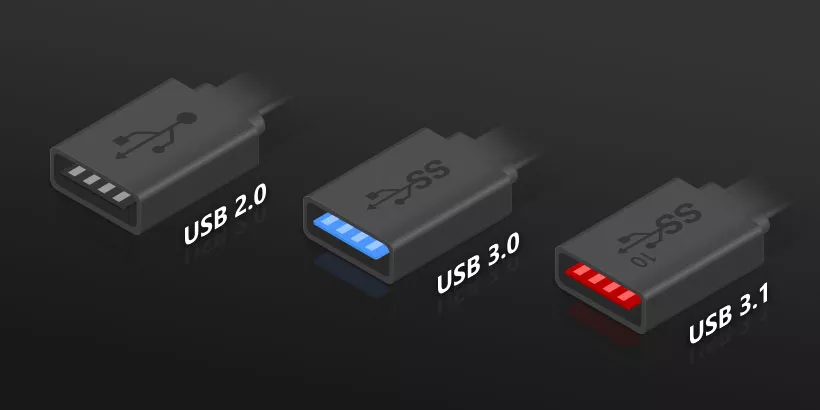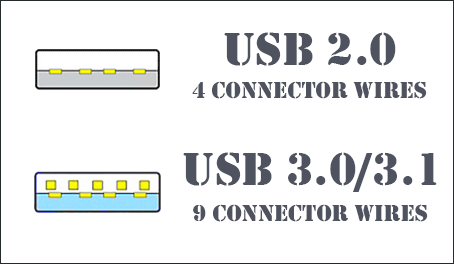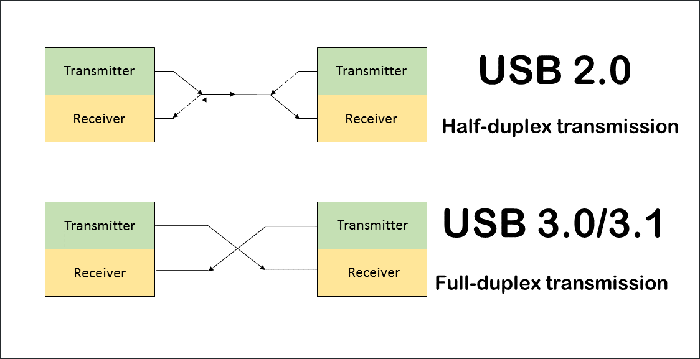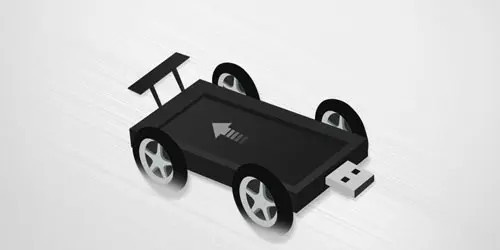What is the Difference between USB 2.0/3.0/3.1 and how to differ them?

Universal Serial Bus (USB) is an industry standard established in 1996. As time went by, it developed a lot and already had 4 generations. Now we're generally using USB 2.0, USB 3.0 (also known as "USB 3.1 Gen 1*1" or "USB 3.2 Gen 1") and USB 3.1 (also known as "USB 3.1 Gen 2*1" or "USB 3.2 Gen 2"). But what is the difference between USB 2.0, 3.0 and 3.1? And how could people differ them from each other? Today, this article is going to address these two questions.
Difference between USB 2.0, 3.0 and 3.1
Appearance
The most obvious difference between USB 2.0 and USB 3.0 is that USB 2.0 port usually comes with a black port while USB 3.x port comes with a blue one.
It's said that the ports of USB 3.1 are mostly colored as blue or red.
But, since it's not mandatory, USB 3.0 ports can also be black and so is USB 3.1.

There is also obvious sign besides USB port or cable.

Numbers of Wires
USB 2.0 flash drive only 4 connector wires whereas USB 3.0 and USB 3.1 port have 5 more, 9 in total.

Bandwidth
USB 2.0 offers a one-way communication path, which allows data to be both sent and received over the same pathway. Therefore, USB 2.0 can only either send or receive data at a time. USB 3.0 and USB 3.1 port apply full duplex data transmission, each with a dedicated function: one for sending data and the other for receiving data, because of which USB 3.0 and USB 3.1 can simultaneously send and receive data.

Speed
Obviously, USB 3.0 port is way faster than a USB 2.0. Theoretically, the maximum speed of USB 2.0 flash drive is 480 Mbps while USB 3.0 flash drive could reach out for about 5 Gbps. And transfer speed of USB 3.1 flash drive could amazingly arrive at 10Gbps by theory.
| Theoretical Maximum Speed | |
|---|---|
| USB 2.0 | 480 Mbps |
| USB 3.0 | 5 Gbps |
| USB 3.1 | 10 Gbps |
Compatibility
USB 3.0 are designed to be backwards compatible, which means that a USB 3.0 flash drive could work normally with USB 2.0 port and the same applies to a USB 3.1 device and USB 3.0 port.
However, since the port is inferior, the device performance will be limited. For example, if users plug their USB 3.1 flash drive into USB 2.0 port, the writing speed will be greatly diminished. Likewise, intense speed decline happens when a USB 3.0 device is plugged into a USB 2.0 port.
| USB 2.0 port | USB 3.0 port | USB 3.1 port | |
|---|---|---|---|
| USB 2.0 drive | √ | √ | √ |
| USB 3.0 drive | √ | √ | √ |
Power usage
USB 2.0 is able to provide up to 500 mA current, whereas USB 3.0 could get to 900 mA. Also, USB 3.0 is capable of delivering more USB power when the need arises and conserve power when the USB flash drive is connected but not being used. USB 3.1 can output 3 A equals to 3000 mA.
| USB 2.0 | USB 3.0 | USB 3.1 | ||
|---|---|---|---|---|
| Appearance | Port color | Black | Blue/black | Red/black |
| Number of wires | 4 | 9 | 9 | |
| Bandwidth | One way | Two paths | Two paths | |
| Theoretical Maximum Speed | 480 Mbps | 5 Gbps | 10 Gbps | |
| Compatibility | USB 2.0 drive | USB 3.0 drive | USB 3.1 drive | |
| USB 2.0 port | √ | √ | √ | |
| USB 3.0 port | √ | √ | √ | |
| Power usage | 500 mA | 900 mA | 3000 mA | |
How to differ USB 2.0 and USB 3.0 and USB 3.1 from each other?
Maybe there are numbers of differences between USB 2.0 and USB 3.0 and USB 3.1, but here we recommend you two most efficient ways to separate them:
First, look at inside of USB port to see the color inside or look for a USB symbol and how many connector wires there.
If it's black and has only 4 connector wires, it's USB 2.0 port.
If it's blue and has 9 connector wires, then it's most likely a USB 3.0 port or a USB 3.1 port.
If it's red and has 9 connector wires, then it's USB 3.1. Now that red port is not general, you may want to try other methods.
And for a cable, there should be an obvious symbol on the surface. And sometimes a USB 3.0 port on a device will be marked "SS".
Second, check out the speed of USB flash drive.
Check transfer speed of the USB flash drives. Plug the device into USB 2.0 and USB 3.0 ports on the computer and copy a large file folder to it, watch the speed on a pop-up window.
Let's assume that the USB device is firstly plugged into the USB 3.0 port. Copy a large file whose size is about 10GB and look at how fast the transfer goes. If an intense speed cutdown happens when the device is plugged into the USB 2.0 port, then it's a USB 3.0 or USB 3.1 port.
If the writing speed could reach up to about 100 MB/s when plugged into USB 3.0 port, then it's a USB 3.1 flash drive.
Below is speed comparison of different devices plugged into different USB ports. Just for reference.
Note: As you can see, a USB 3.0 flash drive plugged into USB 2.0 and USB 3.0 port performs at similar speed. The speed is not only affected by USB port but also USB flash drive itself.
Bottom Line
In this article, we analyze 6 differences between USB 2.0, 3.0 and 3.1, especially between USB 2.0 and USB 3.0 - appearance, number of wires, bandwidth, speed, compatibility and power usage.
And there are mainly two ways to separate them - look at the outside of the USB device, like colors of the ports and the symbol that might be marked on the surface of USB devices or cables and watch the writing speed when transferring a large file to them plugged into USB 2.0 and USB 3.0 port.




















